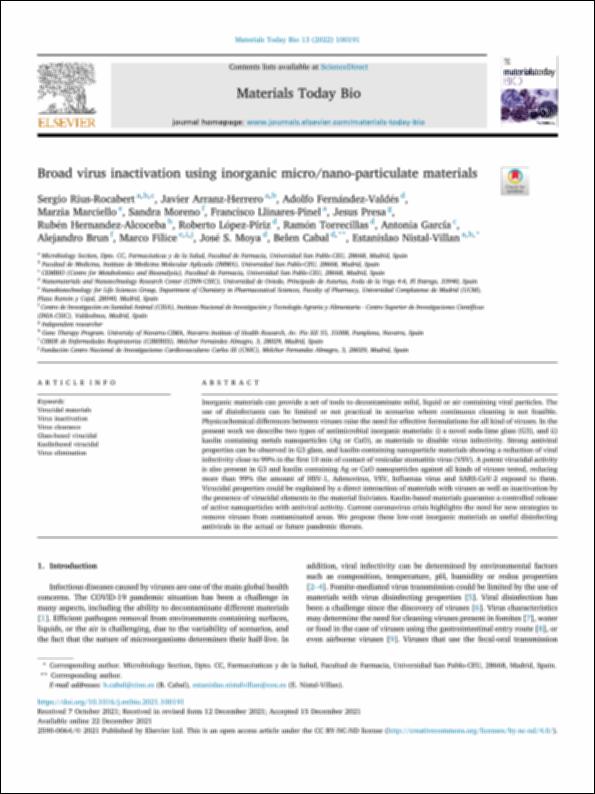Please use this identifier to cite or link to this item:
http://hdl.handle.net/10637/15297Broad virus inactivation using inorganic micro/nano-particulate materials
| Title: | Broad virus inactivation using inorganic micro/nano-particulate materials |
| Authors : | Rius Rocabert, Sergio Fernández Valdés, Adolfo Moreno, Sandra Llinares Pinel, Francisco Presa, Jesús Hernández Alcoceba, Rubén López Píriz, Roberto Arranz Herrero, Javier Marciello, Marzia Torrecillas, Ramón García Fernández, Antonia Brun, Alejandro Filice, Marco Moya, José S. Cabal, Belén Nistal Villán, Estanislao |
| Keywords: | Virucidal materials; Virus inactivation; Virus clearance; Glass-based virucidal; Kaolin based virucidal; Virus elimination |
| Publisher: | Elsevier |
| Citation: | Rius-Rocabert, S., Arranz-Herrero, J., Fernández-Valdés, A., Marciello, M., Moreno, S., Llinares-Pinel, F., Presa, J., Hernandez-Alcoceba, R., López-Píriz, R., Torrecillas, R., García, A., Brun, A., Filice, M., Moya, J. S., Cabal, B., & Nistal-Villan, E. (2022). Broad virus inactivation using inorganic micro/nano-particulate materials. Materials Today Bio, 13. https://doi.org/10.1016/j.mtbio.2021.100191 |
| Abstract: | Inorganic materials can provide a set of tools to decontaminate solid, liquid or air containing viral particles. The use of disinfectants can be limited or not practical in scenarios where continuous cleaning is not feasible. Physicochemical differences between viruses raise the need for effective formulations for all kind of viruses. In the present work we describe two types of antimicrobial inorganic materials: i) a novel soda-lime glass (G3), and ii) kaolin containing metals nanoparticles (Ag or CuO), as materials to disable virus infectivity. Strong antiviral properties can be observed in G3 glass, and kaolin-containing nanoparticle materials showing a reduction of viral infectivity close to 99% in the first 10 min of contact of vesicular stomatitis virus (VSV). A potent virucidal activity is also present in G3 and kaolin containing Ag or CuO nanoparticles against all kinds of viruses tested, reducing more than 99% the amount of HSV-1, Adenovirus, VSV, Influenza virus and SARS-CoV-2 exposed to them. Virucidal properties could be explained by a direct interaction of materials with viruses as well as inactivation by the presence of virucidal elements in the material lixiviates. Kaolin-based materials guarantee a controlled release of active nanoparticles with antiviral activity. Current coronavirus crisis highlights the need for new strategies to remove viruses from contaminated areas. We propose these low-cost inorganic materials as useful disinfecting antivirals in the actual or future pandemic threats. |
| URI: | http://hdl.handle.net/10637/15297 |
| Rights : | http://creativecommons.org/licenses/by-nc-nd/4.0/deed.es |
| ISSN: | 2590-0064 |
| Issue Date: | 2022 |
| Center : | Universidad San Pablo-CEU |
| Appears in Collections: | Facultad de Farmacia |
Items in DSpace are protected by copyright, with all rights reserved, unless otherwise indicated.


